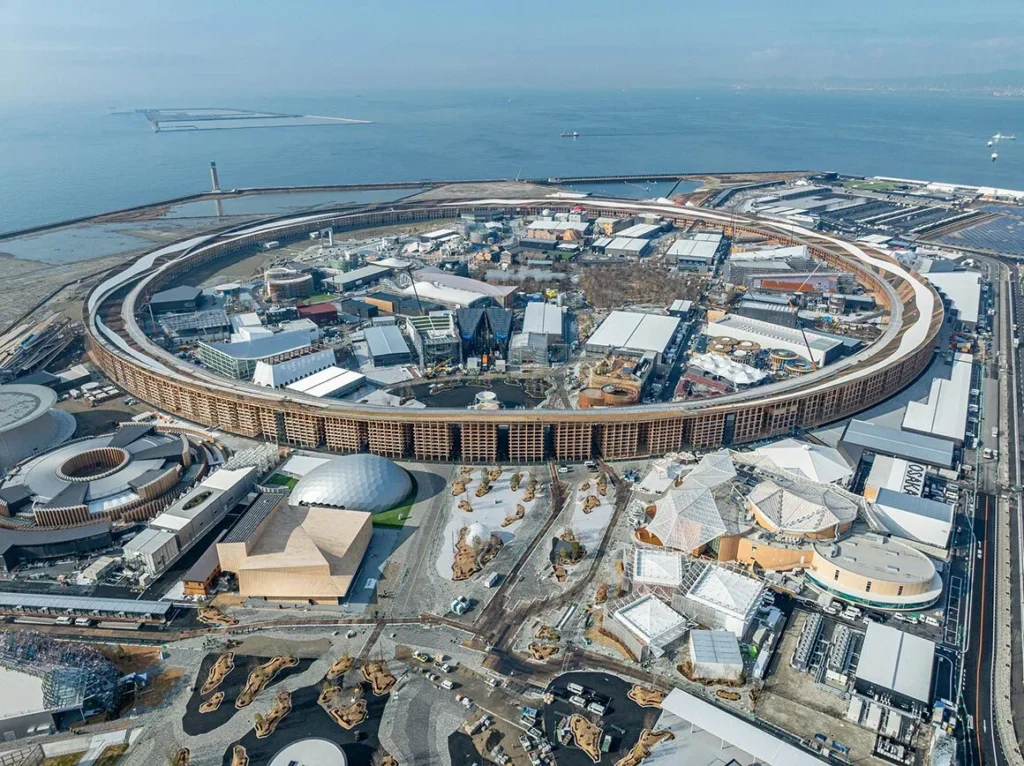Sandwiched between Dubai’s dazzling edition in 2020 (well, technically 2021) and the much-anticipated Riyadh showcase in 2030, EXPO 2025 Osaka, feels a bit more grounded. The theme of ‘Designing Future Society for Our Lives,’ leans into sustainability and innovation, with a tone that feels introspective.
From the get-go, it is clear that Osaka’s organisers are taking sustainability seriously. The EXPO programme doesn’t just check the boxes, it genuinely aims to embed environmental responsibility, social inclusiveness and economic creativity everywhere, making it something you can’t ignore.
Certainly more modest in scale than its Gulf counterparts, Osaka’s EXPO covers 155 hectares—compared to Dubai (438ha) and Riyadh (600ha)—but it is no less ambitious. Housed on a purpose-built, man-made island in Osaka Bay, the site is encircled by an incredible ‘Grand Ring’—a serene and surreal, 22-metre-high wooden structure that stretches 2km around it. Hosting 158 countries and expecting around 28 million visitors, it is undoubtedly a major moment.
As expected, the GCC representation is in full force, with each pavilion bringing a voice rooted in its own heritage, while looking boldly toward the future.
Saudi Arabia

Saudi Arabia’s Together for a Better Future pavilion, designed by Foster + Partners, is both contemplative and alive. Inspired by traditional Saudi towns, guests wind through narrow passages to a central courtyard—a space that shifts from peaceful by day to performance-led by night.
UAE

The UAE opts for a more poetic Earth to Ether title for a pavilion that draws from the date palm, both symbolically and literally. Agricultural waste forms part of the structure and the fusion of Emirati and Japanese materials and techniques speaks to a mutual respect and ecological harmony.
Qatar

Qatar has teamed up with the great Kengo Kuma for its Empowering Lives pavilion, framed in timber and wrapped in a white fabric referencing both Qatari dhows and Japanese craftsmanship. It makes smart use of recycled marine materials like fishing nets, and its floating design creates a lovely dialogue between land, sea, and sustainability.
Kuwait

Kuwait’s Visionary Lighthouse, by LAVA, is bold and architectural. Its winged roof gestures upward like an invitation, the glowing translucent facade comes alive at night, and the interiors draw on Islamic and desert-inspired aesthetics. It is about openness, hospitality, and light—both literal and metaphorical.
Oman
As expected, Oman’s pavilion is grounded in the country’s diverse landscapes and its cultural value of coexistence with nature. Entitled Earth, Water and Humanity, it fits neatly into the Expo’s ‘Saving Lives’ sub-theme, and offers a pause for reflection on how nations can live in tune with the environment—and with each other.
Bahrain
Then there is Bahrain. Lina Ghotmeh’s design, Connecting Seas — A Journey Through the Senses, is arresting. Made entirely of wood with an outer aluminium structure, it nods to Bahrain’s maritime roots and uses traditional cooling techniques to harness sea breezes—a gentle but impactful gesture toward full recyclability and environmental intelligence.
Away from the GCC, I personally enjoyed the Uzbekistan Pavilion, designed by Studio Brückner for the Uzbekistan Art and Culture Development Foundation. Entirely locally sourced, it uses sustainable wood from forests around Osaka, recycled bricks and plans to return to Uzbekistan after the Expo for reuse. It is thoughtful, beautiful and grounded in both tradition and foresight.
To be honest, I sometimes struggle with the idea that everything must be about sustainability. It is a bit of a buzzword. But even with that fatigue, I have to acknowledge how many of these pavilions are genuinely trying—not just to be green, but to rediscover the wisdom embedded in their own cultures. Shading, narrow alleys, rammed earth… we are going back to basics in the best possible way.
And that, in itself, is a kind of education. Because if we want to raise future generations who understand the value of things—of materials, energy, community—we need to start young. Especially in places where abundance risks becoming excess and where the cost of overconsumption is easy to ignore.
Back in 1849, Prince Albert described the first world EXPO as “a true test and a living picture of the point of development at which the whole of mankind has arrived.” In Osaka, that still holds true.

